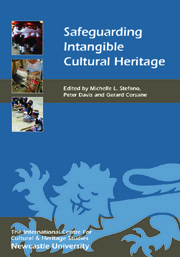Book contents
- Frontmatter
- Contents
- List of Illustrations
- Acknowledgments
- Touching the Intangible: An Introduction
- NEGOTIATING AND VALUING THE INTANGIBLE
- APPLYING THE INTANGIBLE CULTURAL HERITAGE CONCEPT
- ON THE GROUND: SAFEGUARDING THE INTANGIBLE
- 14 Acquiring the Tools for Safeguarding Intangible Heritage: Lessons from an ICH Field School in Lamphun, Thailand
- 15 Intangible Threads: Curating the Living Heritage of Dayak Ikat Weaving
- 16 Conversation Piece: Intangible Cultural Heritage in South Africa
- 17 Revitalising Amerindian Intangible Cultural Heritage in Guyana and its Value for Sustainable Tourism
- 18 When ICH Takes Hold of the Local Reality in Brazil: Notes from the Brazilian State of Pernambuco
- 19 Reconfiguring the Framework: Adopting an Ecomuseological Approach for Safeguarding Intangible Cultural Heritage
- 20 Conversation Piece: Intangible Cultural Heritage in Italy
- 21 Looking to the Future: The en-compass Project as a Way Forward for Safeguarding Intangible Cultural Heritage
- List of Contributors
- Index
17 - Revitalising Amerindian Intangible Cultural Heritage in Guyana and its Value for Sustainable Tourism
from ON THE GROUND: SAFEGUARDING THE INTANGIBLE
Published online by Cambridge University Press: 05 February 2013
- Frontmatter
- Contents
- List of Illustrations
- Acknowledgments
- Touching the Intangible: An Introduction
- NEGOTIATING AND VALUING THE INTANGIBLE
- APPLYING THE INTANGIBLE CULTURAL HERITAGE CONCEPT
- ON THE GROUND: SAFEGUARDING THE INTANGIBLE
- 14 Acquiring the Tools for Safeguarding Intangible Heritage: Lessons from an ICH Field School in Lamphun, Thailand
- 15 Intangible Threads: Curating the Living Heritage of Dayak Ikat Weaving
- 16 Conversation Piece: Intangible Cultural Heritage in South Africa
- 17 Revitalising Amerindian Intangible Cultural Heritage in Guyana and its Value for Sustainable Tourism
- 18 When ICH Takes Hold of the Local Reality in Brazil: Notes from the Brazilian State of Pernambuco
- 19 Reconfiguring the Framework: Adopting an Ecomuseological Approach for Safeguarding Intangible Cultural Heritage
- 20 Conversation Piece: Intangible Cultural Heritage in Italy
- 21 Looking to the Future: The en-compass Project as a Way Forward for Safeguarding Intangible Cultural Heritage
- List of Contributors
- Index
Summary
INTRODUCTION
Within heritage management and museum work, there has traditionally been an emphasis on material culture and the immovable and movable tangible heritage resources. These resources include, for example, landscapes, the built environment, artefacts and a range of physical objects and material that people have produced. When intangible heritage resources have been consulted by heritage and museum practitioners, they were often used simply as a way of understanding and interpreting material culture and tangible heritage (Galla 2008). However, intangible cultural heritage (ICH) sources of evidence, as defined in the Introduction of this volume, are increasingly being viewed as significant and valuable in their own right (Deacon 2004; Kurin 2004).
The history of this increase in recognition can be traced in the work of anthropologists, ethnographers and those involved in folk-life studies (Kurin 2004). The roots of the current international interest in ICH can be traced back through several key UNESCO initiatives. These are the 1989 Recommendations for the Safeguarding of Traditional Culture and Folklore; 1993 Living Human Treasures project; and the 1998 Proclamation of Masterpieces of the Oral and Intangible Heritage of Humanity (Aikawa-Faure 2009, 13). The aims of these initiatives centre around encouraging governments, NGOs and local communities to identify key intangibles in culture and then to identify people as bearers of the knowledge, skills and techniques of these intangibles, who are able to pass them on to others (UNESCO 2011a; 2011b).
- Type
- Chapter
- Information
- Safeguarding Intangible Cultural Heritage , pp. 201 - 212Publisher: Boydell & BrewerPrint publication year: 2012



